|
Bridget Robinson, Manjula Patel and Liz Lyon
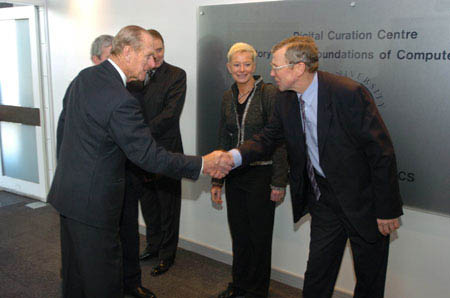
HRH Prince Philip, Chancellor of Edinburgh University, meets Melvyn
Cornish, University Secretary,
during his visit to the DCC in February.
(Photo courtesy of University of Edinburgh and Douglas Robertson Photography)
Following its launch in November, the DCC led by its new Director, Chris Rusbridge, is implementing a programme of training workshops, site visits and events designed to raise awareness of the DCC and its activities. These have included a meeting with the JISC Preservation Programme projects. Later this year, the 1st International DCC Conference will be held at the Hilton, Bath, UK on 29-30 September 2005 with the Opening Keynote given by Graham Cameron, Associate Director of the European Bioinformatics Institute. The Closing Address will be delivered by Clifford Lynch, Executive Director of CNI.
The DCC is also developing practical services including fact sheets, briefing papers, tutorials, FAQs and a curation manual. Furthermore, the DCC has set up an Associates Network, open to all institutions in the HE and FE sectors served by JISC, and to all research organisations, individuals and groups engaged in digital curation and preservation. The Network has a Web-based Discussion Forum for Associates for the exchange of views, information and expertise.
The DCC development team is in the process of investigating a distributed model for the long-term curation and preservation of resources. Current work centres on the design and implementation of a Representation Information Registry and Repository (DCC-RR). Representation Information (RI) is used as in the context of the OAIS model, meaning all information that may be necessary to access and understand the information content of a digital data object.
Persistent access to RI is the key to long-term curation and preservation of digital information. The team also seeks as far as possible to facilitate interoperability and automated processing of digital information. Further information is obtainable from the document DCC Approach to Digital Curation and the DCC will be giving a demonstration at the forthcoming JISC Conference in Birmingham in April.
Further information
UK Digital Curation Centre http://www.dcc.ac.uk/
What is digital curation? http://www.dcc.ac.uk/what.html
White paper: DCC Approach to Digital Curation http://dev.dcc.rl.ac.uk/twiki/bin/view/Main/DCCApproachToCuration
The South West Museums Libraries & Archives Council (SWMLAC) has launched its first ICT Masterclass Programme aimed at providing a unique professional development opportunity for staff in the Region. The innovative Programme comprises five sessions which together cover a range of topics including leadership, aspects of strategic management, organisational development and the management of change. The first part, Positioning the Sector in the Global Knowledge Space, was held in January at The Watershed, Bristol and was led by Liz Lyon. The session was a mix of presentations (from Liz, Jonathan Drori, Director, Culture Online, and Graham Barrett, Head of IT Services, Test Valley Borough Council) and highly participative group work.
The Programme will conclude with a One-Year Review session in January 2006, where delegates will be able to assess their progress in implementing ICT-enabled change within their organisations. The Masterclass Programme has been developed by members of the SWMLAC ICT Steering Group and is a key element of the Regional ICT Strategy.
Further Information:
SWMLAC http://www.swmlac.org.uk/

DC is pretty much a staple part of the resource discovery menu these days. It was also on the real menu, in the unusual form (by UK standards!) of Duck Chins, at an excellent restaurant visited on the final night of the Dublin Core International Conference in Shanghai last October. But it wasn't all play: the two UKOLN staff who attended the conference contributed to a very successful event, e.g. by leading tutorials, chairing working group meetings and contributing editorial effort to the DC Usage Board. In general, UKOLN staff continue to make a significant contribution to the work of the Dublin Core Metadata Initiative.
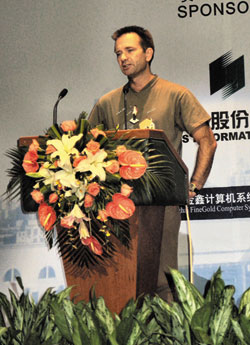
Andy Powell presenting during the tutorial track at DC-2004
( Photo courtesy of Stu Weibel, OCLC )
Two recent activities are worth highlighting. Firstly, the DCMI Abstract Model, jointly authored by staff at UKOLN and the Royal Institute of Technology in Sweden, has become a proposed recommendation, a significant step towards becoming a full DCMI Recommendation. Secondly, UKOLN staff have helped set up a new joint ODRL-DCMI working group, with the aim of improving the combined use of the Open Digital Rights Initiative (ODRL) 'rights' markup language and DC descriptive metadata records.
Further Information:
Dublin Core Metadata Initiatitive http://dublincore.org/
International Conference on Dublin Core & Metadata Applications 2004 http://dc2004.library.sh.cn/english/prog/
Joint DCMI/ODRL Profile Working Group established
http://dublincore.org/news/#odrl
International Conference on Dublin Core & Metadata Applications 2005 http://dc2005.uc3m.es/
Royal Institute of Technology, Stockholm, Sweden (KTH)
http://www.kth.se/eng/
In the last focus we took a brief look at the JISC Information Environment Service Registry (IESR) and considered what standards it should support in order to integrate into the service landscape most effectively. Since then UKOLN has taken part in an IESR workshop, which sought the views of the community about this important service.
One issue that needs to be considered is that of centralisation. Given that we are likely to see the development of multiple service registries in the UK context and beyond, both at institutional and national level, we probably need to consider the IESR as one component in a widely distributed network of service registries. Therefore, we need to try to reach agreements about how such registries are going to cooperate, both at a technical and a policy level. One critical question to be answered is whether the current suite of Web service standards, like UDDI, are the right way of distributing our service registries or whether we'd be better off adopting 'digital library' approaches like the OAI-PMH as our underlying transport protocol.
Like the DNS, it seems likely that the closer we can hold the data in the service registries to the data owners, the better. And like the DNS, the success of the service can probably be measured by how invisible it becomes!
Further Information:
JISC Information Environment Service Registry http://iesr.ac.uk/
Collection Description Focus has published two more titles in its Case Study series, which records experiences with various implementations of collection description databases.
Case Study 3 by Rachel Perkins describes the Collections Navigator at the Natural History Museum (NHM) as an "efficient and effective complement to item-level cataloguing". Around 750 collection description records are now available. Additionally, collection descriptions are seen as a tool to aid collections management within the NHM. Work on Collections Navigator has also contributed to the BioCASE Project, which aims to provide Web-accessible information on biological collections in Europe.
Case Study 4 by Chris Turner at MLA describes the Cornucopia database of collections held by cultural heritage institutions throughout the UK. The first version of Cornucopia, set up in 1998, held information on 62 museums, while the redesigned version launched in 2004 now holds information on more than 6,000 collection descriptions from almost 2,000 institutions. It is expected that more descriptions will be added to the database in the next few years.
The case studies are available online and hardcopy versions are available on request.
Further Information:
Collection Description Case Study Series
http://www.ukoln.ac.uk/cd-focus/case-studies/
MLA The Museums, Libraries and Archives Council
http://www.mla.gov.uk/
Natural History Museum
http://www.nhm.ac.uk/
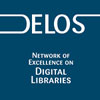 UKOLN
has been responsible for the coordination of a state-of-the-art overview of
activities and research in areas relating to semantic interoperability in digital
library systems. This has recently been completed as part of the DELOS cluster
activity of Work Package 5: Knowledge Extraction and Semantic Interoperability
(KESI).
UKOLN
has been responsible for the coordination of a state-of-the-art overview of
activities and research in areas relating to semantic interoperability in digital
library systems. This has recently been completed as part of the DELOS cluster
activity of Work Package 5: Knowledge Extraction and Semantic Interoperability
(KESI).
A major aim of the report is to integrate views from overlapping communities working in the area of semantic interoperability; these include: semantic web, artificial intelligence, knowledge representation, ontology, library and information science and computer science.
Definitions of interoperability, syntactic interoperability and semantic interoperability are presented noting that semantic interoperability is very much about matching concepts as a basis.
The overall goal of semantic interoperability is to support complex and advanced, context-sensitive query processing over heterogeneous information resources. The report examines several areas in which semantic interoperability is important in digital library information systems, these include: improving the precision of search, enabling advanced search, facilitating reasoning over document collections and knowledge bases, integration of heterogeneous resources, and its relevance in the information life-cycle management process. The report also investigates some theoretical issues such as clarification and selection of relevant terminology, standardisation and interpretation and the differing levels of semantic interoperability in digital library environments. It notes that information structure, language and identifiable semantics are prerequisites of semantic interoperability, as is consensus building and standardisation.
Further Information:
Knowledge Extraction & Semantic Interoperability (KESI) (WP5)
http://delos-wp5.ukoln.ac.uk/
There seems to be an increasing tendency to adopt a Service-Oriented Architecture (SOA) approach to modelling our information and service landscapes. The most obvious examples of this in our community are the JISC E-Learning Framework (ELF) and the related eResearch-focused Virtual Research Environment (VRE), though there are also similar activities elsewhere, for example, the Sakai and VIEWS initiatives.
While this approach appears to work well, both as a tool for making informed policy decisions and as a way of developing and deploying interoperability standards, it can result in a complex matrix of services. We need to find ways of presenting a more coherent view of our somewhat messy service landscape (including the JISC IE) and reach agreements, preferably at an international level, about how to document the 'reference models' being built up through these kinds of activities.
One recent activity worth taking a closer look at is the US Digital Library Federation's Framework Working Group, which is trying to identify ways of documenting our environment from the general (a high-level 'business requirement') right through to the specific (a 'deployed service' on the network).
Further Information:
JISC e-Learning Framework
http://www.jisc.ac.uk/index.cfm?name=elearning_framework
JISC Virtual Research Environments Programme
http://www.jisc.ac.uk/index.cfm?name=programme_vre
The Subject Portals Project (SPP), funded by JISC, has recently completed Phase II. The principal aim was to develop portal tools for subject-based communities. All eight RDN Hubs participated in the project, with UKOLN providing project management and ILRT the technical lead.
At the same time as developing beta subject portals for each of the RDN Hubs, the project has made the resulting software available as open source. The objective was to develop portable functionality, by creating a series of 'portlets' or modules, designed to sit within a portal framework. The portlet approach means that Hubs (and other users) have a choice of the functions they install. The software is also customisable by both administrators and users.
The portlets build on the core functions (authentication, customisation and user data storage) and include cross-searching, newsfeeds, alerting, and 'additional services' such as e-journal searching.
The software complies with the key emerging portal standards: WSRP, the communication protocol which allows portals to aggregate remote portlets, and JSR168, the Java portlet standard. This means that SPP portlets can be embedded in third-party portal environments, such as uPortal. Other key standards implemented include XML, Java, SOAP, Z39.50, OAI, RSS.
So, what do users think? Testing has revealed that they are particularly impressed with the ability to cross-search a range of resources in their subject area. Users can search according to a profile, or they can select resources individually. The system can also alert users to relevant new resources. The search mechanism has mainly used the Z39.50 protocol, but is extensible (e.g. OAI has also been used within the project).
Further Information:
Subject Portals Project http://www.portal.ac.uk/spp/

Panorama of Heraklion, Crete.
(Photo courtesy of Martin Doerr, FORTH)
 New contributors to Revealweb, the database of materials in accessible formats, include the North Wales Society for the Blind, whose materials are in Welsh, and the Scottish Braille Press. There are now 110,738 titles on the database and 97 organisations listed on the register of suppliers. Revealweb has been welcomed by users, as instanced by John Godber of RNIB. Using a laptop PC, wirelessly connected to a BBC Internet 'listen again' page, he was listening to a play, based on a book, about a 19th century Scottish detective called James McLevy. Using the same wireless connection he then connected to Revealweb, where a keyword search located a Braille copy at the National Library for the Blind (NLB).
New contributors to Revealweb, the database of materials in accessible formats, include the North Wales Society for the Blind, whose materials are in Welsh, and the Scottish Braille Press. There are now 110,738 titles on the database and 97 organisations listed on the register of suppliers. Revealweb has been welcomed by users, as instanced by John Godber of RNIB. Using a laptop PC, wirelessly connected to a BBC Internet 'listen again' page, he was listening to a play, based on a book, about a 19th century Scottish detective called James McLevy. Using the same wireless connection he then connected to Revealweb, where a keyword search located a Braille copy at the National Library for the Blind (NLB).
He pasted the details into the email link for NLB and requested the item, which arrived three days later. He says, "It couldn't be easier. No more wondering if you've got the strength to ask for and wade through catalogues from various organisations; no more having to make several phone calls. It's now easier for me as a blind person to borrow a book than it is for a sighted person. I don't have to wait for the library to open. Revealweb is 24/7."
Ann Chapman of UKOLN, who produced the bibliographic standard for Revealweb, continues to provide advice to the Database Management Group and is a member of the Policy Advisory group.
Further Information:
Revealweb
http://www.revealweb.org.uk/
We are currently seeing interest in new Internet applications, including instant messaging, Internet telephony, Blogs and Wikis. One of UKOLN's roles is to provide a technology watch on emerging networked technologies and help ensure our communities are aware of their potential.
A joint UKOLN/UCISA workshop was held in Leeds in November 2004 on Beyond Email: Strategies for Collaborative Working and Learning in the 21st Century. During the event delegates had an opportunity to exploit the venue's WiFi network to employ these new tools to enrich collaboration with fellow delegates. The feedback on the event was very positive. However a number of potential dangers were identified, such as disruption, distraction and legal concerns, to which a narrow focus on new Internet-based authoring applications could perhaps leave us vulnerable.
Other factors identified included security and administration issues regarding both resources and infrastructure, as well as scalability issues ranging from 'chatroom overload' to accidental overwriting of resources. Deployment requires careful planning to avoid the inadvertent establishment of a two-track system and consideration should be given to building a critical mass of social contacts and a structure that suitably reflects institutional culture and group dynamics. Ultimately, the technologies were felt to be most usefully applied when they played a specific role, particularly for teaching and learning support.
Further information:
Emma Tonkin, Making the Case for a Wiki, January 2005, issue 42 Ariadne
http://www.ariadne.ac.uk/issue42/tonkin/
Brian Kelly, Web Focus: Experiences of Using a Wiki for Note-taking at a Workshop,
January 2005, issue 42 Ariadne
http://www.ariadne.ac.uk/issue42/web-focus/
The People's Network have been running a series of workshops that aim to increase access, take-up and engagement with ICT in Public Libraries as part of the Framework for the Future action plan. The People's Network workshops aim to let public libraries know what resources are out there and how they can use them to support excluded groups, create an online community and support access to digital services, etc. As a representative of the Interoperability Focus team, I attended the London-based workshop Community Content Creation: Enabling online community content creation to flourish in February.
The majority of the presentations given were about online resources that allow ordinary people to create their own content. Peter Brophy introduced the Cultural Objects in Networked Environments (COINE) Project, a scheme which allows European citizens to create narratives, publish sound recordings and display photographs and pictures online. The stories come from a very wide range of people including travellers, those living in poverty, war zones and disaster regions. People's War is a similar project co-ordinated by the BBC which looks specifically at World War 2. Katherine Campbell, who presented on this topic, explained how such a project not only maintains an important oral tradition but also brings a generation of people (the over-60s) to the Internet who have never used it before ('silver surfers'!). One of the key issues that became apparent, and of particular interest to UKOLN, was the need to future-proof the unique records being created.
Further information:
Framework for the Future Digital Citizenship Workshop Series 2005
http://www.mla.gov.uk/action/pn/events.asp
COINE Project
http://www.uoc.edu/in3/coine/
http://www.cultivate-int.org/issue7/coine/
People's War
http://www.bbc.co.uk/dna/ww2/
Chris Rusbridge visited UKOLN in mid-March in his new role as Director of the Digital Curation Centre. Chris talked to the UKOLN-based team and outlined his thoughts on future strategy and activities for the Centre. Liz and Chris will be presenting a paper on the DCC at the forthcoming CNI Spring Taskforce meeting in Washington in April.
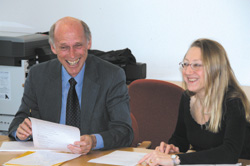
Chris Rusbridge and Liz Lyon
Further information:
Digital Curation Centre http://www.dcc.ac.uk/
cni Task Force Meeting April 2005, Washington, DC http://www.cni.org/tfms/2005a.spring/index.html
Michael Heaney's Analytical Model of Collections and their Catalogues provided the underlying model for the development of the Research Support Libraries Programme (RSLP) Collection Level Description Schema. Since then a body of experience on implementing collection descriptions has been built up, including work on the Dublin Core Collection Description Application Profile (DC CD AP) - which arose in part from concerns about the maintenance and ownership of the RSLP Schema - and the JISC Information Environment Service Registry (IESR).
One specific issue that has emerged is that of disclosing information on the services that provide access to collections. Such services are outside the scope of the current entity-relationship model and therefore are not covered specifically in the RSLP Schema. This means that implementations such as the IESR that wish to include information about services are having to find ways to do this without guidance from the model as to how this information relates to other parts of a collection description.
In order to support further work in this area, UKOLN has now commissioned Michael Heaney, Head of Service Assessment and Planning, Oxford University Library Services, to extend the model to define the entities and relationships involved. His report is expected to be available at the end of April 2005.
Further Information:
Michael Heaney's Analytical Model of Collections and their Catalogues
http://www.ukoln.ac.uk/metadata/rslp/model/
ePrints UK is a JISC-funded project, part of the Resource Discovery Network (RDN), that has developed a service to facilitate the discovery of eprints across all the institutional eprint archives available in the UK. This was primarily a proof of concept project, to evaluate the technical requirements of such a service.
Necessary back-end functions are implemented by a harvester that collects records from most UK institutional eprint repositories which are then indexed locally for searching via a Web interface. This service is also exposed via the standard Z39.50 protocol. The service currently exposes more than 63,000 records from more than 30 different repositories.
The ePrints UK service was developed on a software base derived from the central RDN Resource finder service, and therefore represents a significant reuse of development time. Its internal structure remains similar, with the exception of a few necessary eprints-specific modifications. The service adds more advanced searching capabilities, such as the option to search a selection of repositories.
Further Information:
ePrints UK Service http://eprints.rdn.ac.uk/
ePrints UK Project http://www.rdn.ac.uk/projects/eprints-uk/
ePrints UK Technical Report http://www.rdn.ac.uk/projects/eprints-uk/docs/technical/eprints-tech-report.pdf
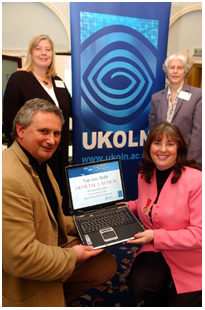
(Clockwise) David Hill, SWMLAC, Alison Baud, University of Bath Library,
Ann Chapman, UKOLN and Councillor Loraine Morgan-Brinkhurst
(Photo courtesy of The Bath Chronicle)
A former Mayor of Bath joined archivists, librarians and museum curators at the launch of the Tap into Bath database on 8 December 2004. This collaborative project to describe all the collections in the city of Bath was jointly led by the University of Bath Library and Learning Centre and UKOLN.
The database now describes a wide variety of collections. These include several museums covering subjects from costume to postal services, and from east Asian art to Americana, together with the public art gallery, university and college libraries, the public library, the library of a water utility and a hospital, the public record office, the university archives, the local newspaper library and archives, and the library, museum and archive collections of the Bath Royal Literary and Scientific Institution.
A fascinating range of materials is held in addition to the expected
books, documents, paintings, sculptures and ceramics;  there are fossils and
herbaria, shells and ethnic items, scrapbooks and photographs, china dogs and
furniture, Coronation gloves and tradesmen's tools, to mention only a few.
Amongst other details, entries for collections describe the type of materials
held, the subject area covered, who can use the collections, when they are open,
if there are entry charges, and additional information on the availability of
educational resources and access for those with physical or sensory impairment.
there are fossils and
herbaria, shells and ethnic items, scrapbooks and photographs, china dogs and
furniture, Coronation gloves and tradesmen's tools, to mention only a few.
Amongst other details, entries for collections describe the type of materials
held, the subject area covered, who can use the collections, when they are open,
if there are entry charges, and additional information on the availability of
educational resources and access for those with physical or sensory impairment.
Ariadne issue 42 includes a report on the launch and the experience of being a participant, by Stephanie Round.
Further Information:
Tap into Bath http://www.bath.ac.uk/library/tapintobath/
Stephanie Round: Tap into Bath Takes Off
http://www.ariadne.ac.uk/issue42/tapintobath-rpt/
Guardian Unlimited , 23 February 2005
http://society.guardian.co.uk/e-public/story/0,13927,1420203,00.html
As projects kick off and close, UKOLN is inevitably faced with making farewells as much as welcoming colleagues to new projects.
Thus in October we were sorry to say goodbye to Pete Dowdell who worked as developer on RDN systems from January 2002 and was responsible for the development of the EnrichUK Portal which serves the many projects of the completed NOF-digi Programme. Pete was also technical advisor to these projects as a leading member of the NOF Technical Advisory Service run by AHDS and UKOLN. Equally the R&D Team was very grateful to Amanda Closier who completed her work on user requirements for the JISC Information Environment Service Registry in December 2004.
In October Emma Tonkin joined the Interoperabilty Focus Team and began work, among other things, on collaborative tools, writing an article for Ariadne issue 42 on this topic. This January we welcomed back Marieke Guy on return from maternity leave. Marieke is also working on the Interoperabilty Focus Team. She has already completed two items for the Spring issue of Ariadne.
Further Information:
UKOLN Staff http://www.ukoln.ac.uk/ukoln/staff/
Google continues to have a significant impact on our resource discovery habits; the ways in which our own content and services interface with Google and similar services is becoming increasingly important. The advent of the likes of Google Scholar has just served to make more visible what we knew was happening anyway - that much of the community sees Google as their first and foremost port of call. As Lorcan Dempsey said in his regular column for CILIP Update, "increasingly 'on web' means available in Google" and therefore content and service providers need to turn their "systems inside out, and try to make the functionality that was available only within monolithic search systems now available on the open web".
How do we respond to this? At a national level we need to ensure that the high-quality material that is made available on the Web through public funding is included in services like Google Scholar. And at an institutional and individual level, we need to ensure that our content is made available in robot-friendly forms and with URIs that will remain persistent over time. A report that considers these issues in more detail is available from UKOLN's JISC IE Web site.
Further Information:
JISC Information Environment
http://www.jisc.ac.uk/index.cfm?name=ie_home
The JISC Information Environment and Google: a discussion paper
http://www.ukoln.ac.uk/distributed-systems/jisc-ie/arch/ie-google/
Welcome to Issue 2 of focus with its mixture of news and comment from across all teams here at UKOLN. All authors and references, including sometimes lengthy urls are available at http://www.ukoln.ac.uk/focus/, the Web version. I take this opportunity to thank all the people who have contacted colleagues or myself with comments and congratulations on the first issue of the re-designed newsletter.
UKOLN also publishes Ariadne, a Web magazine for information professionals in archives, libraries and museums in all sectors. The current issue is no. 42 while the Spring issue will contain articles, among others, on the nature of trust in global virtual teams and its effect on distributed working; on best practice and dissemination in digital preservation; and from the US and UK, an article on autodiscovery for rapid information movement. There will also be an article on what the Internet has to offer the largest arts audience in the United Kingdom: readers.
 Accessibility issues feature in a number of areas of UKOLN's work, and it's an area that is rapidly changing at present. The CETIS-TechDis Accessibility SIG (Special Interest Group) provides a useful forum to learn more about accessibility issues and solutions, through its four meetings a year and its email list. Ann Chapman attended the meeting in York on 16 March. There were presentations on current issues such as content development, assistive technology and standards, developing an accessible version of the Creation of Study Environments (COSE) VLE software, and implementation of the IMS Accessibility for Learner Information Package (ACCLIP) specification in the Loughborough Personal Profile Project.
Accessibility issues feature in a number of areas of UKOLN's work, and it's an area that is rapidly changing at present. The CETIS-TechDis Accessibility SIG (Special Interest Group) provides a useful forum to learn more about accessibility issues and solutions, through its four meetings a year and its email list. Ann Chapman attended the meeting in York on 16 March. There were presentations on current issues such as content development, assistive technology and standards, developing an accessible version of the Creation of Study Environments (COSE) VLE software, and implementation of the IMS Accessibility for Learner Information Package (ACCLIP) specification in the Loughborough Personal Profile Project.
Meanwhile, a SiteMorse report of January 2005 cites the low level of compliance with W3C's Web Content Accessibility Guidelines (WCAG) across UK disability organisations' Web sites. The report's methodology, based on use of SiteMorse's automated robot, has been criticised for providing no user testing. However the WCAG guidelines themselves cover areas of accessibility which can be detected by automated tools (e.g. the presence of alt tags for images) and those which require user testing (e.g. relevance of alt tag content).
The SiteMorse report did not address this impasse. UKOLN, working with TechDis and a software developer at CDNTL, University of Bath's e-learning unit, has recently published a paper entitled Developing a Holistic Approach for E-Learning Accessibility in the Canadian Journal of Learning and Technology, Vol. 30 (3). It argues that the WCAG guidelines provide a valid starting point for addressing Web accessibility, but must address wider issues including usability, resource implications and local factors as well as the needs of e-learning and its learning outcomes. A pre-print of the paper is available on the UKOLN Web site.
Further Information:
CETIS-TechDis Accessibility SIG (Special Interest Group) http://www.cetis.ac.uk/accessibility/
TechDis http://www.techdis.ac.uk/
Developing A Holistic Approach For E-Learning Accessibility, Kelly, B., Phipps, L. and Swift, E. Canadian Journal of Learning and Technology, 2004, Vol. 30, Issue 3.
http://www.ukoln.ac.uk/web-focus/papers/cjtl-2004/
Editor's note: The Spring issue of Ariadne will carry an article on the 10th CETIS-TechDis Accessibility SIG meeting.
eBank UK is a JISC-funded project which brings together chemists, digital librarians and computer scientists in an interdisciplinary collaboration which explores the potential for integrating research datasets into digital libraries by using common technologies such as the Open Archives Initiative Protocol for Metadata Harvesting (OAI-PMH).
An OAI-PMH repository was created at the University of Southampton using a modified version of the eprints.org software. A number of datasets from the chemistry sub-discipline of crystallography were deposited in the archive, which offers a local browse and search interface, tailored to crystallography.
UKOLN contributed by helping to design a metadata schema, based on Dublin Core, used to describe the datasets. Metadata harvesting was then carried out and a demonstrator was built to show the potential for linking the datasets to publications. User scenarios were employed to help understand requirements in this specialised area which deals with complex digital objects.
Phase 2 of the project has now been funded to research the use of complex digital object descriptions and their application in describing scientific data. Another strand of work will explore the pedagogical potential of linking research datasets with e-learning. A workshop was recently held at the University of Bath in which participants from different scientific activities, both in the UK and the European mainland, discussed the feasibility and requirements of schema descriptions.
Further Information:
eBank UK Project page
http://www.ukoln.ac.uk/projects/ebank-uk/
Emma Tonkin and Gregory Tourte
A software patent directive is currently awaiting EU Parliament approval having been passed, controversially, by the European Commission. Patents grant an inventor sole rights to an original, non-obvious and novel invention for a limited time. The period for which the patent applies is regarded as sufficient for the inventor to profit while being sufficiently restricted, once the patent expires, to ensure the invention retains its relevance.
Patentability of software is controversial; software, like most published material, is already protected by copyright. The question hinges on the way one defines software. Software patents in the US frequently result in the patenting of features - ideas - such as one-click shopping or on-line authentication or expressing rights via XML. This locking away of ideas combined with a patent validity period that exceeds by far the lifetime of any given operating system has given software patents a deservedly bad name.
A broad software patent directive is likely to damage the availability or legality of open source software, a particularly damaging prospect for academic, governmental and non-profit organisations. A further issue concerns 'submarine' patents, broad patents that lie unenforced until they become widely used by the industry, and which can then be used to claim undeserved royalties on the work of others.
Many feel a reasonable compromise would involve patentability of software/hardware combinations only, to prevent excessively broad patents and an artificial monopoly on software. Moreover, patents can be used to lock competitors out of the market entirely.
As software patents begin to be introduced in European countries, a shared stance is required. Given the reservations that exist in respect of this patent directive, now might be the time for action.
Further information:
Foundation for a Free Information Infrastructure (FFII) http://www.ffii.org/
Since their introduction in the mid-1980s, the periodic Research Assessment Exercises (RAEs) have become a familiar part of the UK Higher Education landscape, with the next exercise due in 2008. A recent report produced by Michael Day for the JISC-funded ePrints UK Project has highlighted some of the ways in which institutional repositories may be able to help support research evaluation processes like the RAE.
Perhaps the most promising approach, at least in the short term, would be for institutions to use repositories to manage the metadata about research outputs required for the RAE submission process. The University of Southampton's recent recommendation that its research repository should be used as the central data management tool for RAE 2008 would appear to demonstrate the current viability of this approach.
In the longer term, it might be possible to use repositories to generate automatically quantitative data that could be used by RAE assessment panels to support their deliberations. There has already been some research into the development of tools for the statistical analysis of citation linking and usage data generated from repositories. This research demonstrates the potential value of these tools in supporting research evaluation in the future. However, the findings of the Roberts Review of the RAE (2003) suggest that future exercises are likely to remain largely dependent on peer-review.
Further information:
EPrints UK - Documents http://www.rdn.ac.uk/projects/eprints-uk/docs/
rae2008 Research Assessment Exercise http://www.rae.ac.uk/
Members of UKOLN are involved in the DELOS cluster Knowledge Extraction and Semantic Interoperability (KESI) which met in January. The DELOS Network of Excellence Review took place in March with a positive outcome and the partners are looking forward to the next Joint Programme of Activity.
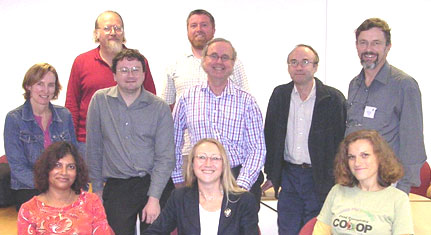
Members of the DELOS KESI team during a meeting at UKOLN in September